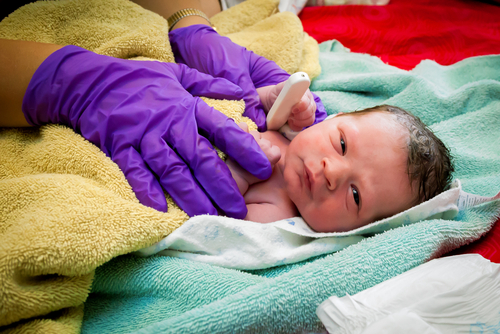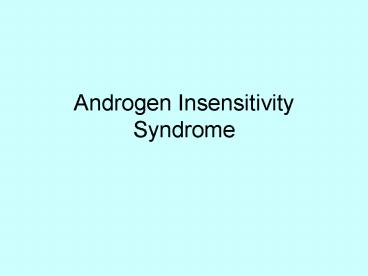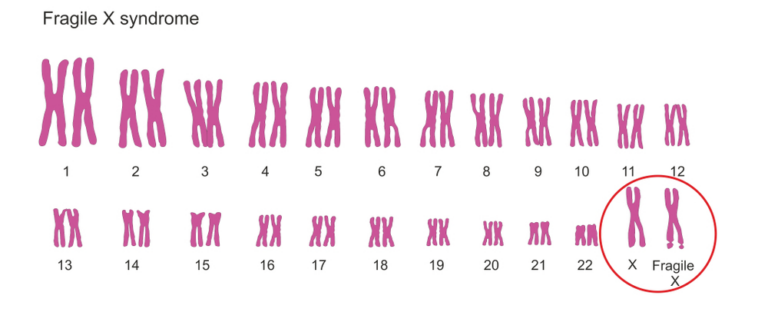From XX to XY: The Complexities of Turner Syndrome and Female Infertility
Table of contents
What is Turner Syndrome?
Turner syndrome, or Monosomy X, is a condition that only affects females. It arises when one of the X chromosomes is absent, totally or partially. This syndrome can result in several issues for the individual like short height, heart defects, and a failure of the ovaries to develop properly. From XX to XY: The Complexities of Turner Syndrome and Female Infertility.
The syndrome can be diagnosed prenatally (before birth), during infancy, or early childhood. In some cases where the symptoms are very mild, the diagnosis can be delayed until the teen years or the young adult years of the affected individual. The individuals affected by this syndrome require constant medical care from different specialists. A regular checkup with them can help most of them lead a healthy and independent life.
What is the Cause of the Syndrome?
This syndrome is not inherited. It is a random event that happens in the early stages of development in the womb. There is no evidence that the mother’s age predisposes a baby to an increased risk of having this syndrome.
One in 2,500 live female births is estimated to be the prevalence rate of Turner syndrome.

What are the Types of Turner Syndrome?
The type of Turner syndrome present in an individual is dependent on the particular problem with the X chromosome. They are:
- Monosomy X – Instead of having two X chromosomes, each cell has just one. This occurs in about 45% of people with this syndrome. It occurs from the mother’s egg or the father’s sperm randomly forming without the X chromosome; this affects the baby’s cell after fertilization.
- Mosaic Turner syndrome – Also referred to as 45, X mosaicism, this type is seen in about 30% of cases. Some of the baby’s cells have a pair of X chromosomes, while others have only one pair. This occurs randomly during the cell division in pregnancy.
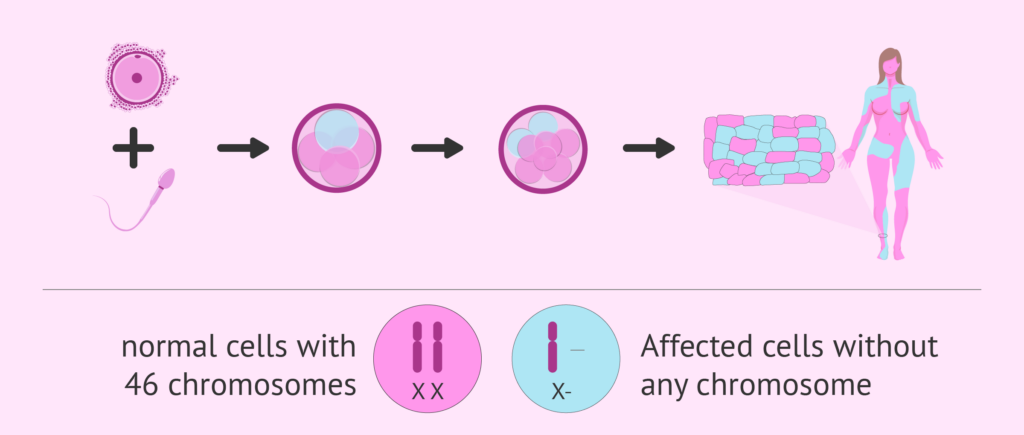
- Inherited Turner syndrome – This is very rare. When this occurs, it means that the babies may have inherited the syndrome. This means that the parent or parents were born with it and passed it on. This type usually occurs because of a missing part of the X chromosome.
What are the Symptoms of the Condition?
Females with Turner syndrome can exhibit different symptoms at different stages of their lives, which are infancy, childhood, and adulthood. However, many of these symptoms are not distinct and are not always easy to connect to the syndrome. Some of these symptoms include:
Infancy
Some of the symptoms that may be observed in infancy include:
- Small size
- Heart abnormalities
- Difficulty in feeding
- Swelling of the hands and feet
- Extra folds in the neck
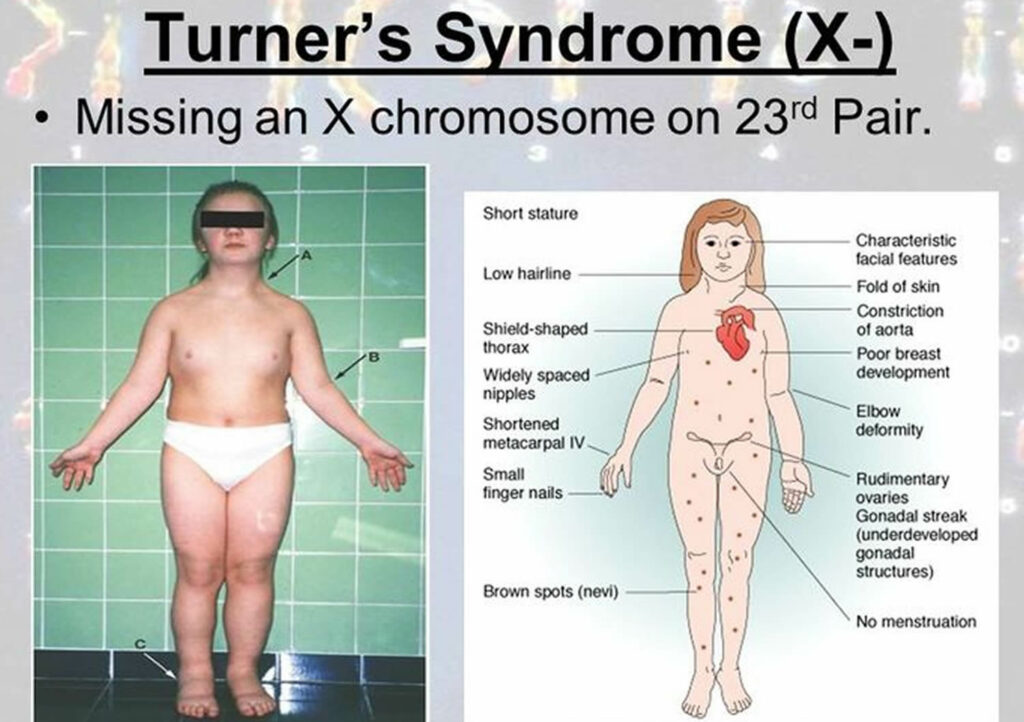
Childhood and teenage years
As the individual with the syndrome matures, the signs become more obvious. Some of them include:
- Below average height and weight
- Smaller stature than their peers
- Hearing difficulties
- Chronic ear infections
- Difficulties in learning
Underdevelopment of the ovaries is a main issue in Turner syndrome. It is because the ovaries are responsible for the production of sex hormones. This underdevelopment can slow down or even stop the normal signs of puberty. This can include the normal development of the breasts and even menstruation.
Adulthood
When the syndrome is not addressed or if the syndrome is very severe, some of the symptoms seen in adulthood include:
- Heart issues
- Hearing issues
- Small stature
- Irregular menstruation
What are the Complications that Result from this Syndrome?
Turner syndrome can affect the proper development of different body systems. However, this effect is varied among the different individuals with this syndrome. The different complications that can be seen include:
- Heart issues – This is common with most individuals born with this syndrome. They are born with heart defects or even slight abnormalities in their heart structure which increases their risk of serious complications. These defects can be problems with the aorta or other structures in the heart.
- High blood pressure – The syndrome can increase an individual’s risk of high blood pressure which can predispose the individual to strokes.
- Vision problems – Turner syndrome can come with an increased risk of strabismus, nearsightedness, and other vision problems.
- Hearing loss – This is common with the syndrome. In some cases, it is due to the gradual loss of nerve function. It can also result from an increased risk of frequent middle ear infections.
- Kidney problems – The syndrome can be associated with malformations of the kidney. This may lead to urinary tract infection risks.
- Infertility – Most of the females with Turner syndrome are infertile. A small number may, however, become pregnant spontaneously, while others become pregnant through fertility treatment.
- Pregnancy complications – Since women with this syndrome are more disposed to risks that occur with pregnancy like high blood pressure and aortic dissection, they should be evaluated by a cardiologist and a maternal-fetal specialist before pregnancy.
- Mental health problems – Females with this syndrome may have issues in functioning in social situations. They may experience anxiety and depression. They may also have an increased risk of attention deficit disorder.
- Learning difficulties – While individuals with this syndrome have normal intelligence, they have an increased risk of learning disabilities. Especially with learning that involves math, memory, attention, and spatial concepts.
- Skeletal issues – Problems with the growth and development of bones increase the risk of abnormal curvature of the spine and forward rounding of the upper back. The syndrome can also increase the risk of developing weak and brittle bones.
- Autoimmune disorders – Turner syndrome can increase the risk of an underactive thyroid due to the autoimmune disorder called Hashimoto’s thyroiditis. They also are at an increased risk of diabetes. It can also be associated with gluten intolerance or inflammatory bowel disease.
How is the Syndrome Treated?
Turner syndrome currently has no cure, although there are strategies to control the symptoms and enhance quality of life. Apart from the symptom-based treatment of the syndrome, the therapy focuses on hormone treatment and this includes:
- Estrogen therapy – This type of therapy can help in the development of breasts and start their menstruation. Additionally, it might aid in their uterus attaining a normal size. The therapy can also help with brain development, heart function, liver function, and skeletal health.
- Cyclic progestins – These hormones are often started at age 11 or 12 if the blood tests indicate a deficiency. They act to induce cyclic menstrual periods. The treatment is often started with very low dosages and then gradually increased to stimulate normal puberty.
- Human growth hormone – Injections of this hormone can help increase the height if it is started early enough. It has been found that it can increase the final height by up to several inches.
Can a Woman with Turner Syndrome get Pregnant?
Women with this syndrome are usually infertile, which means that they cannot get pregnant. However, some of them can use assisted reproductive technology to achieve their aim of growing a family. Surrogacy, especially can help. For women in countries that do not allow surrogacy, they can always turn to medical tourism. There are special medical travel agencies or meditour agencies that offer overseas medical treatment that can help in carrying out the surrogacy arrangements. This can be seen as a form of health tourism.
The information provided in this blog is for educational purposes only and should not be considered as medical advice. It is not intended to replace professional medical consultation, diagnosis, or treatment. Always consult with a qualified healthcare provider before making any decisions regarding your health. Read more

